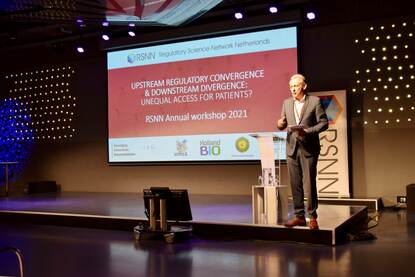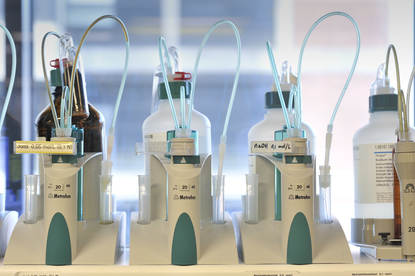In order to guide our scientific activities, the MEB has identified eight themes in the MEB regulatory science policy 2020-2024, in which we will invest in the coming years. Sharon Essink conducts research into risk management and risk minimization measures, which is in line with the theme Safety and effectiveness after authorization. The PhD project of Bram Storosum is focuses on Gender differences. This topic is not directly linked to one of the eight themes in the science policy 2020-2024, but is receiving more and more attention, amongst others by the focus group gender within the MEB.
Sharon Essink obtained her master’s degree in Biomedical Sciences at the Radboud University in Nijmegen. During her master’s, she focused on epidemiology and clinical pharmacology/toxicology. Sharon started her PhD project at the University Utrecht on the 1st of December 2021 (50% of the time). For the other 50% of the time, she will be trained as a pharmacovigilance assessor at the Medicines Evaluation Board (MEB). For more information, please contact Sharon via science@cbg-meb.nl.

PhD highlight: Sharon Essink
“Risk management and risk minimization measure during the life cycle of a product”
Start: 01-12-2021. End: 30-11-2026.
Promotors: Prof. Marieke De Bruin (Utrecht University), Dr. Sabine Straus (MEB)
Co-promotors: Dr. Inge Zomerdijk (MEB)
Introduction
Within pharmacovigilance, the European Union Risk Management Plan (EU-RMP) is important in the proactive life cycle management of medicines and facilitates identification, characterization, monitoring and minimisation of risks. Within the EU-RMP, the risk minimisation plan describes the measures that aim to prevent the occurrence and/or severity of adverse drug reactions (i.e. risk minimisation measures). Routine risk minimisation measures are in place for all medicines, such as the product information. Some medicines may be associated with important risks for which additional risk minimisation measures (aRMMs) are needed to ensure a positive benefit-risk balance. Examples of aRMMs are educational materials and pregnancy prevention programmes.
Evaluation of the effectiveness of aRMMs is needed to determine whether risks are sufficiently minimised when the medicine is used in clinical practice and whether aRMMs may be stopped or amended. Both quantitative and qualitative research can be used in these evaluations. It is important to evaluate the methods applied in the aRMM effectiveness studies to strengthen future studies and better facilitate regulatory and public health needs.
Aim
This PhD project aims to provide insight in effective risk minimisation measures during the life cycle of medicines and in the need, value and challenges of different types of evaluations of aRMM effectiveness. The results may give insight in how to improve future aRMMs and aRMM effectiveness studies and may be used to improve various Good pharmacovigilance practices (GVP) guidelines on risk management and risk minimisation.

Bram Storosum received his master’s degree in Medicine in 2019 and started his PhD project in the same year alongside his residency in psychiatry at the Amsterdam University Medical Center (Amsterdam UMC), combining clinical practice with research. For more information, please contact Bram via science@cbg-meb.nl.
PhD highlight: Bram Storosum
“Gender differences in pivotal registration trials in antipsychotic medications for schizophrenia and acute mania”
Start: 05-07-2019. End: 01-10-2024.
Promotors: Prof. Damiaan Denys (Amsterdam UMC), Prof. Lieuwe de Haan (Amsterdam UMC)
Co-promotors: Dr. Taina Mattila (MEB), Dr. Jasper Zantvoord (Amsterdam UMC)
Introduction
Schizophrenia and acute mania are amongst the leading causes of disability worldwide, affecting both gender. In schizophrenia and acute mania, although gender differences in incidence per age category are found, there is no gender difference in the various prevalence measures. Antipsychotic medication has been proven effective in pivotal clinical trials for these disorders.
However, women are underrepresented in pivotal drug trials conducted in patients with schizophrenia, which are not powered to infer reliable gender-specific similarities or differences in effect. In acute mania, there are indicators for differences between genders, for example in etiology and course of the disease, however differences in effect size of antipsychotic medications remain underinvestigated.
Appropriate enrolment of women in these clinical trials and gender specific-analysis of data may be critical with regard to expected efficacy, dosing, and safety of therapeutic agents. Furthermore, gender specific analyses may yield valuable information for clinical practice.
Aim
The aim of this project is to explore the difference in effect size between men and women suffering from schizophrenia and acute mania through individual patient data meta-analysis of placebo controlled registration trials for antipsychotic medication. Where applicable, steps for the assessment of future clinical trials and regulatory safety studies, with regard to gender, will be recommended. Suggestions may be made with regard to the guidelines for the treatment of schizophrenia and acute mania. This project furthers the understanding and awareness of gender differences both in regulatory science as well as clinical practice.

Britt Duijndam is a PhD student since 2015, at the division of Drug Discovery & Safety from the Leiden Academic Centre for Drug Research (LACDR, Leiden University) under supervision of Prof. Bob van de Water and Dr. Jan Willem van der Laan. Britt’s project focuses on nuclear hormone receptors. SHe combines her PhD position with a position as a non-clinical assessor at the Pharmacology, Toxicology and Kinetics (FTK) group within the MEB. Britt is expected to complete her PhD research this year.
For the MEB science day she made this video presentation about her PhD project. For more information, please see the abstract below or contact Britt via science@cbg-meb.nl.
PhD Highlight: Britt Duijndam
Estrogen receptor alpha proliferative signaling in predicting carcinogenic potential
Author(s)
Britt Duijndam1,2, Tineke van den Hoorn2, Joost Beltman1, Peter Bouwman1, Jan Willem van der Laan2, Bob van de Water1
Affiliation
- Division of Drug Discovery & Safety, Leiden Academic Centre for Drug Research, Leiden University, Leiden, The Netherlands
- Section on Pharmacology, Toxicology and Kinetics, Medicines Evaluation Board, Utrecht, The Netherlands
Background
Pro-proliferative estrogen receptor alpha (ERα) signaling is recognized as one of the mechanisms of non-genotoxic carcinogenicity which represents a major risk in human tumor development. Several biochemical and cell-based assays for the detection of compounds with estrogenic properties have been developed, but these are not suitable for the monitoring of pathway activation dynamics, and are mostly based on expression constructs lacking physiological promoter regulation.
Methods
We have developed MCF7 fluorescent reporter cell lines of 3 different GFP-tagged ERα target genes: GREB1, PGR and TFF1. These reporters are under control of the full physiological promoter region and allow the monitoring of dynamic pathway activation on a single cell level using a live-cell imaging set-up. In addition, we link activation of the ERα pathway to a potential adverse outcome by additionally monitoring cell cycle progression and proliferation.
Results
We extensively characterized these reporters and have evaluated their performance to a full reference set of known estrogenic compounds as defined by the Organisation for Economic Co-operation and Development (OECD) Performance-based Test Guideline 455. Currently, we are focusing on the relation of GFP reporter activity with overall transcriptional regulation of cell cycle pathways by employing next generation sequencing. Additionally, our single-cell data allows us to integrate protein expression data and cell cycle progression in a mechanistic computational model to improve our understanding of pathway activation and cell proliferation.
Conclusion
In conclusion, our reporter platform represents a weight-of-evidence approach which will provide a better understanding of ERα pathway activation in the context of cellular proliferation. This, in turn, will yield improved risk assessment of carcinogenicity for human health.
During the MEB Science Day 2022, Britt gave a more extensive presentation about her work:
*Ambient music plays*
Logo CBG MEB appears on screen.
On-screen text: MEB Science Day.
Britt Duijndam.
Britt Duijndam:
Hi. Thank you for listening.
My name is Britt Duijndam.
In this presentation...
I would like to give you an overview
of my PhD project...
where we developed a reporter platform
for oestrogen receptor alpha sickening.
Exposure to certain pharmaceuticals
or compounds...
can result in tumour development in humans.
Whereas genotoxic compounds
can be readily identified in vitro...
we mostly rely on lifetime rodent bioassays
for the detection of non-genotoxic carcinogens.
However, this lifetime rodent bioassay
has its limitations.
In line with the 3R-principle...
known as the replacement,
reduction and refinement of animal testing...
more efforts are being made
to develop cell-based assays.
But since the mode of action
of these non-genotoxic carcinogens...
is quite complex and diverse,
this remains challenging.
Whereas genotoxic compounds mostly rely
on DNA damage as their mode of action...
the mode of action
of non-genotoxic carcinogens is diverse.
And we wanted to focus
on receptor-mediated endocrine modification.
This receptor binding
can have various consequences...
such as the induction of cellular processes
such as proliferation, apoptosis, homeostasis...
and this can eventually culminate
in tumour development.
In this project, we studied
one of these involved receptors...
namely the oestrogen receptor alpha.
To evaluate and link this complex ERa sickening
pathway to non-genotoxic carcinogenicity...
we made use
of an adverse outcome pathway framework.
This AOP is a simplified presentation
of a biological process...
which describes the link
between the initial chemical interaction...
and the occurrence of adverse effects,
by using a series of key events.
When we fill out this AOP for ERa activation in
relation to proliferation, it will look like this.
So as a molecular initiating event,
the receptor will be bound by a compound...
translocate to the nucleus,
where it acts as a transcription factor.
This will lead to the first key event,
namely the transcription of target genes...
followed by subsequent key events
like cell cycle progression and proliferation...
ultimately culminating in tumour formation.
To integrate this AOP
into human risk assessment...
it is essential to carefully define
and quantify these key events.
For this purpose,
we established fluorescent reporters...
which in combination
with advanced live cell imaging...
allow for time- and concentration-dependent
assessment of pathway activation.
To monitor the first key event, target activation...
we carefully identify three target genes,
namely GREB1, PGR and TFF1.
These targets fit in our AOP because they are
inducible by our model compound E2...
which is also known as 17ß-estradiol.
This is the endogenous ligand
of the oestrogen receptor alpha...
and also a known
human non-genotoxic carcinogen.
Secondly, this induction is completely
dependent on oestrogen receptor alpha...
and we have demonstrated that they
play a role in E2-induced proliferation.
With BAC-GFP technology, we've coupled these
three target genes to a green fluorescent protein.
These constructs
make use of an endogenous promoter.
This better reflects the regulation
of these targets in the human situation.
Next, we transfected these constructs
in human MCF7 cells.
In this way, we developed
three different fluorescent reporters.
In combination
with advanced live cell imaging...
we can monitor the dynamic of pathway
activation in these individual reporters...
on a single-cell level.
When we quantify the GFP expression over time,
displayed in the graphs...
the three reporters demonstrate
concentration-dependent activation.
However, they show clearly distinct
activation dynamic patterns over time.
Now that we have covered the first key event,
we move on to the second key event.
To monitor cell cycle progression, we
developed another reporter in the MCF7 cells...
which is based
on a cell cycle indicator construct.
We named this cell line, or this reporter,
we named it MCF7-FUCCI.
This FUCCI reporter makes use of two different
genes coupled to two different fluorescent tags.
Geminin coupled to GFP
and Cdt1 coupled to RFP.
These genes have distinct expression patterns
in the cell cycle.
So based on the expression of the tags...
we can determine in which phase
a cell is residing over time.
We employed this FUCCI reporter
to look at the link between target activation...
and cell cycle progression.
By using small interfering RNAs...
we knock down the expression of the
individual target genes in the FUCCI reporter...
expose the FUCCI reporter to E2 and monitor
the cell cycle progression over time.
As expected, cell cycle progression is inhibited
after knockdown of these target genes...
which can be seen in the time-lapse movies.
Whereas control cells keep progressing
through the cell cycle upon exposure to E2...
cells with knockdown of PGR or TFF1 tend to
reside for a longer period in the G1 phase.
Interestingly, cells with knockdown of GREB1
tend to accumulate in the G1-S transition phase.
This is also reflected in the graph...
where we show the fraction of cells in each
cell cycle phase at the end of our experiment.
This clearly indicates
that these genes have a different role...
in cell cycle progression and proliferation.
Currently, we're further looking
into this role of the genes...
by using whole transcriptome
next generation sequencing.
As I hopefully demonstrated, we've established
a human cell-based reporter platform...
which can provide us more insight
in pro-proliferative ERa signalling...
by covering different key events in the pathway.
But can this reporter platform
also detect other estrogenic compounds...
besides our model compound E2?
And is it able to discriminate between
non-estrogenic and estrogenic compounds?
For this purpose, we used a reference set
as defined by the OECD test guideline.
This list of reference compounds...
is composed of a wide variety of non-estrogenic
and estrogenic compounds...
ranging from very potent pharmaceuticals
to very weak industrial phenolics.
We've exposed our four reporters...
and collected concentration response curves
at different time points for each reporter.
In this way, we monitor
the different key events of the pathway.
Namely, target activation
by monitoring GFP intensity...
FUCCI fractions
reflecting cell cycle progression...
and additionally, we determined
the total amount of cells to reflect proliferation.
Based on the generated
concentration response curves...
we determined the potency of each compound
reflected by EC50 value.
When we incorporate these EC50 values...
of each compound for each reporter
at a different time point in one single heat map...
we are clearly able to discriminate
non-estrogenic from estrogenic compounds...
and we can cluster the estrogenic compounds
based on their potency in different clusters.
Finally, we also compared
the performance of our reporters...
to other OECD-validated assays.
Based on the EC50 values, our reporters
are equally sensitive as other assays.
To summarize,
our human cell-based reporter platform...
can monitor ERa pathway activation
on a single cell level...
and by additionally monitoring
cell cycle progression and proliferation...
we can link activation of the pathway
to a potential adverse outcome.
By making use of endogenous regulation,
this better reflects the human situation.
Besides that, it can identify various estrogenic
compounds with different potencies...
with a similar sensitivity
as other OECD-validated assays.
All in all, it represents
a weight-of-evidence approach...
which provides a better understanding of ERa
pathway activation in the context of proliferation.
In turn, this will yield in
improved risk assessment for human health.
*Ambient music plays and fades out*
Logo CBG MEB, Medicines Evaluation Board appears on screen.












